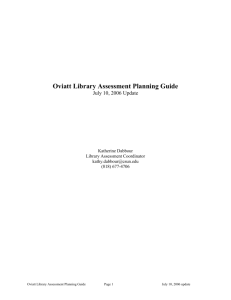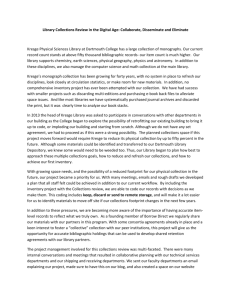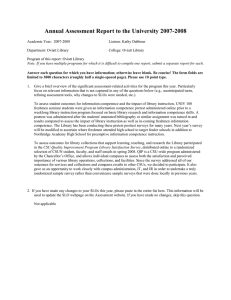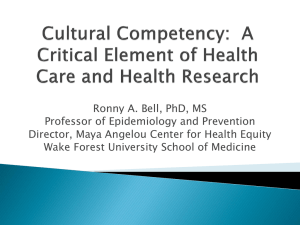Assessment Plan, 2004-05
advertisement
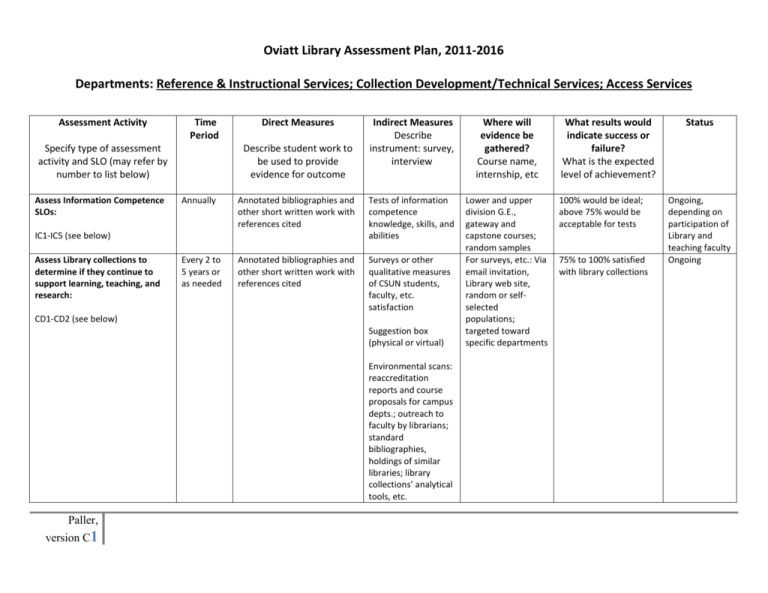
Oviatt Library Assessment Plan, 2011-2016 Departments: Reference & Instructional Services; Collection Development/Technical Services; Access Services Assessment Activity Time Period Specify type of assessment activity and SLO (may refer by number to list below) Assess Information Competence SLOs: Direct Measures Describe student work to be used to provide evidence for outcome Where will evidence be gathered? Course name, internship, etc Lower and upper division G.E., gateway and capstone courses; random samples For surveys, etc.: Via email invitation, Library web site, random or selfselected populations; targeted toward specific departments Annually Annotated bibliographies and other short written work with references cited Tests of information competence knowledge, skills, and abilities Every 2 to 5 years or as needed Annotated bibliographies and other short written work with references cited Surveys or other qualitative measures of CSUN students, faculty, etc. satisfaction IC1-IC5 (see below) Assess Library collections to determine if they continue to support learning, teaching, and research: Indirect Measures Describe instrument: survey, interview CD1-CD2 (see below) Suggestion box (physical or virtual) Environmental scans: reaccreditation reports and course proposals for campus depts.; outreach to faculty by librarians; standard bibliographies, holdings of similar libraries; library collections’ analytical tools, etc. Paller, version C1 What results would indicate success or failure? What is the expected level of achievement? 100% would be ideal; above 75% would be acceptable for tests 75% to 100% satisfied with library collections Status Ongoing, depending on participation of Library and teaching faculty Ongoing Assessment Activity Time Period Specify type of assessment activity and SLO (may refer by number to list below) Assess services and facilities to determine if they continue to support learning, teaching, and research: Direct Measures Describe student work to be used to provide evidence for outcome Every 2 to 5 years or as needed Indirect Measures Describe instrument: survey, interview Where will evidence be gathered? Course name, internship, etc Surveys or other qualitative measures of CSUN students, faculty, etc. satisfaction For surveys, etc.: Via email invitation, Library web site, random or selfselected populations; targeted toward specific departments S1-S9 (see below) Suggestion box (physical or virtual) What results would indicate success or failure? What is the expected level of achievement? 75% to 100% satisfied with library services Status Ongoing Track comments received by service area supervisors Environmental scan Oviatt Library Outcomes Given the Library’s unique role as a provider of information and services to students, faculty, staff, and the general community, as well as an instructional support unit, the Library’s faculty identified three areas for assessment: • • • Information competence (IC) student learning outcomes Collections that support Information Competence Student Learning Outcomes, and faculty teaching and research Services that support Information Competence Student Learning Outcomes, and faculty teaching and research Furthermore, whereas the Library’s many service points often play a role in teaching students IC skills, and whereas all departments in the Library have quality service outcomes, we are presenting our “Program Learning Outcomes” based on either the department that is most involved in facilitating the outcome, or as a group of outcomes that cross all three of our departments. Paller, version C2 Reference & Instructional Services Department Program Learning Outcomes: Information Competence SLOs: IC1: Determine the nature and extent of the needed information IC2: Access needed information effectively and efficiently IC3: Critically evaluate information sources IC4: Use information effectively to accomplish a specific purpose. IC5: Demonstrate understanding of how to access and use information ethically and legally Collection Development/Technical Services Department Outcomes: Collections that support learning, teaching, and research: The Oviatt Library . . . CD1: Collects and provides access to a variety of primary and secondary print, manuscript, media, and electronic resources to support the curricular and research information needs of students and faculty. CD2: Actively engages in outreach to collaborate with faculty on the development of library collections to support curricular and research needs. All Library Departments’ Outcomes: Services that support learning, teaching, and research: The Oviatt Library . . . S1. Provides courteous, capable, and responsive service that demonstrates professionalism and pride in our work. S2. Creates a physical environment conducive to study and research. S3. Provides open hours that takes into consideration both the schedules of our students and faculty and the realities of budgetary constraints. S4. Provides skillful and engaging individualized point-of-use instruction, both in-person and virtual, that helps students develop their information competence skills. S5. Actively engages in outreach to collaborate with faculty to develop assignments and instructional experiences that develop students’ information competence skills. S6. Provides skillful and engaging classroom instruction, which helps students develop their information competence skills. S7. Facilitates searches for needed information by maintaining the efficient organization of and timely access to the Library’s print and manuscript collections, including course reserves. S8. Facilitates searches for needed information by maintaining the efficient organization of and timely access to electronic resources via its Web pages, including course reserves. S9. Facilitates use of audio/video resources by maintaining the efficient organization of and timely access to media resources, including collections, equipment, streaming video, and the University Video Network. Paller, version C3


